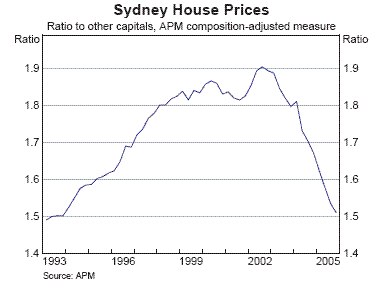Sydney and the Rest: Convergence in House Prices
Yesterday’s RBA Statement on Monetary Policy included the following chart, showing the ratio of Sydney to other capital city house prices, using the composition-adjusted APM series:

The chart suggests the possibility of a long-run equilibrium relationship between capital city house prices. Note that the adjustment is coming from both sides: Sydney house prices are falling, while those in other capital cities are still rising, in some cases quite strongly. As noted previously, those capital cities benefiting most from the commodity price boom are still experiencing strong house price growth. Since the boom in commodity prices is exogenous to the Australian economy, this implies that it is broader economic developments that are driving house prices, not the other way around. Internal migration is also likely to be a factor in driving convergence.
Previously, we have also noted that the global price shock to residential property as an asset class invalidated attempts to explain national house prices with reference to country-specific factors, such as changes in capital gains tax. This chart also implies that these simplistic mono-causal explanations are also invalidated from the bottom-up. The national story obscures what is happening on a state-by-state basis.
posted on 14 February 2006 by skirchner
in Economics
(6) Comments | Permalink | Main
|

Comments
Its clear that the commodity price boom is driving house prices in WA, NT and to a lesser extent in other states, but what are the “broader economic developments” in NSW and Victoria that are depressing house prices?
To me, its clear that it was high house prices that created the exodous from NSW. It was high house prices that resulted in unprecedented levels of debt, and more recent belt-tightening. It was the breaking of the housing boom that resulted in slower growth and rising unemployment in NSW and Victoria, not the other way around.
David Uren says in the Oz on the weekend:
http://www.theaustralian.news.com.au/common/story_page/0,5744,18031650%255E643,00.html
“In the western suburbs of Sydney such as Fairfield and Liverpool, unemployment has risen over the past year from 8.2percent to 9.9 per cent.
The outer western suburbs of Melbourne such as Broadmeadows have suffered an increase in unemployment from 5.5 per cent to 7.8 per cent over the last year.”
Those are recession numbers!
Please tell us all, what exactly was the cause of the housing bust and slow down in NSW and Victoria? Something a bit more specific than “broader economic developments” please.
Posted by .(JavaScript must be enabled to view this email address) on 02/14 at 10:52 AM
It is very likely the Q4 national accounts will confirm a recession in state final demand for NSW when they are released on 1 March. You have alluded to some of the factors, but I think it is mistaken to look for “the cause.” Part of what I am criticising here is the tendency to look for one factor that explains everything. Things are rarely that simple, even though people seem to find comfort in mono-causal explanations.
Posted by skirchner on 02/14 at 02:54 PM
Well ok, give me a list of the five main causes of the (soon to be) recession in NSW.
Posted by .(JavaScript must be enabled to view this email address) on 02/14 at 04:18 PM
Ok, seeing as you can’t come with any specific reason for the recession in NSW, here’s one suggestion: The strength of the Australian dollar since 2003.
Tim Colebatch explains in The Age today:
Imports menace industry
http://www.theage.com.au/news/business/imports-menace-industry/2006/02/16/1140064203799.html
“A STUNNING 20 per cent jump in the import bill last month has underlined the intense pressure on Australian goods producers amid continued low growth in domestic demand.
This trend is likely to continue as long as the Australian dollar stays high and companies use offshore suppliers.”
“For January alone, manufactured imports totalled $10.3 billion, up 11 per cent on a year ago and 24 per cent on two years ago. At a time when consumer spending has grown little more than 10 per cent, it highlights the inroads that imports are making on domestic manufacturing.”
“The importing of finished goods and parts was also bad news for manufacturing employment in Australia.
ABS statistics showed that 56,000 industrial jobs were lost last year. Ai Group has estimated that another 40,000 will go this year, representing about 4 per cent of the 1 million factory jobs left in Australia.”
——————
The damage that the strong AUD is doing to exporters is the great untold story of the economy at the moment. How this can go largely unreported is beyond me.
Posted by .(JavaScript must be enabled to view this email address) on 02/17 at 08:55 AM
The AUD real effective exchange rate is at its highest level since the late 1980s, which is one of the reasons the official cash rate is 75 bp below its previous cycle peak. The contractionary implications are readily discernable in the growth subtraction from net exports, although exports are now picking up somewhat.
On growth differences between the states, see the Hansard of RBA Governor Macfarlane’s testimony before the House Economics committee today.
Posted by skirchner on 02/17 at 01:31 PM
The mining companies may increase capacity and export volumes in coming months, but outside of resources sector exports are shrinking.
Go talk to a manufacturer and feel their pain.
Posted by .(JavaScript must be enabled to view this email address) on 02/17 at 01:48 PM